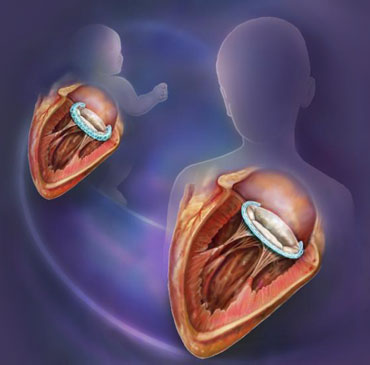This stretchy implant could help kids avoid repeated open-heart surgeries
The elastic ring would ‘grow’ with a child’s heart

SURGERY SAVER A new kind of stretchy medical implant could limit the number of times pediatric patients have to go under the knife.
A3pfamily/Shutterstock
- More than 2 years ago
A new stretchy prosthetic could reduce the number of surgeries that children with leaking heart valves must undergo.
The device, a horseshoe-shaped implant that wraps around the base of a heart valve to keep it from leaking, is described online October 10 in Nature Biomedical Engineering. In adults, a rigid ring is used, but it can’t be implanted in children because it would constrict their natural heart growth. Instead, pediatric surgeons cinch their patients’ heart valves with stitches — which can break or pull through tissue as a child grows, requiring further surgery to repair.
It’s not uncommon for a child to require two to four of these follow-up procedures, says study coauthor Eric Feins, a cardiac surgeon at Boston Children’s Hospital and Harvard Medical School. Doctors in the United States perform over 1,000 pediatric heart valve repair surgeries each year.
“It’s quite invasive to do surgeries on a beating heart,” says coauthor Jeff Karp, a biomedical engineer at Brigham and Women’s Hospital in Boston. To decrease the need for these open-heart follow-up procedures, Karp and colleagues invented a new type of implant that stretches as its wearer grows. It’s made of a biodegradable polyester core covered by a mesh tube. The material of this outer sleeve is interwoven like a Chinese finger trap, so when heart valve tissue grows and tugs on the tube’s ends, it stretches. Over time, the core dissolves, and the growing tissue can pull the sleeve into a longer, thinner shape.

By tweaking an implant’s initial length and width, the core’s chemical makeup and the tightness of the sleeve’s braid, the researchers can fine-tune the stretchiness. This could allow developers to tailor each device to accommodate an individual patient’s expected growth rate.
“This is a brand new idea. I’ve never seen anything like it before,” says Gus Vlahakes, a cardiac surgeon at Massachusetts General Hospital in Boston, who was not involved in the study. “It’s a great concept.”
Karp and colleagues tested prototypes of the heart implant by inserting them into growing piglets. Twenty weeks after surgery, the implants had expanded as expected. The biomedical device company CryoLife, Inc. is now using the researchers’ design to build ring implants for further studies in lab animals, Karp says. “Clinical trials could start within a few years, if all goes well,” he says.
This growth-accommodating design may also be repurposed to make other kinds of pediatric implants. For instance, stretchable devices could supplant the stiff plates and staples that surgeons currently use to treat bone growth disorders. The researchers’ new implant model is “very generalizable,” Vlahakes says.





